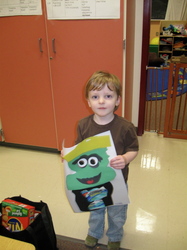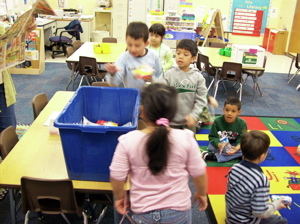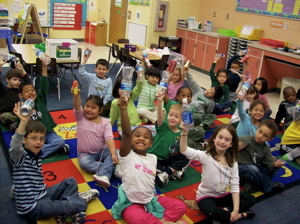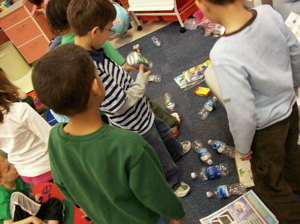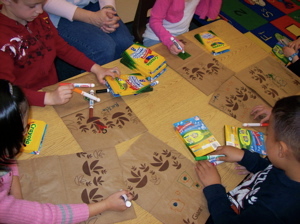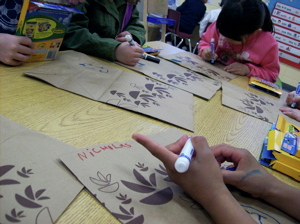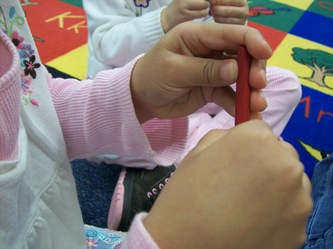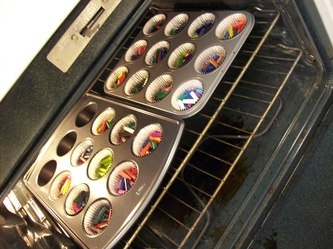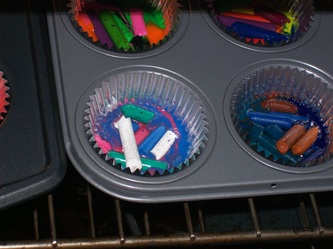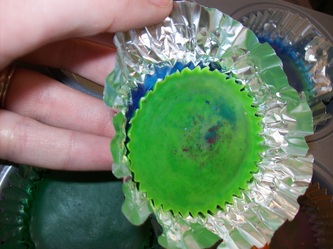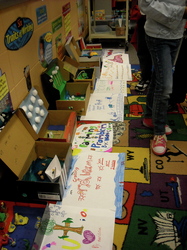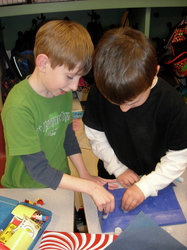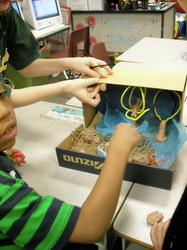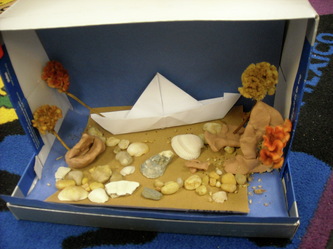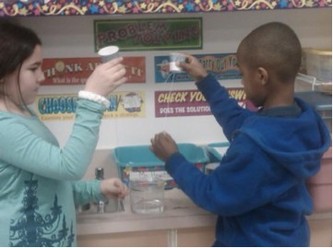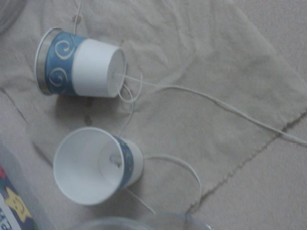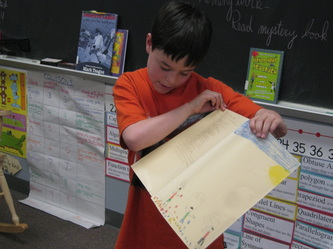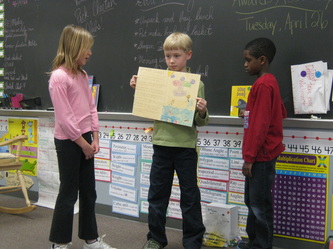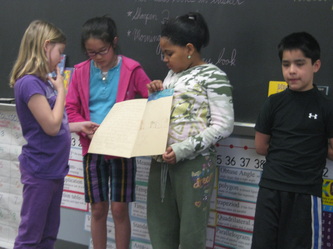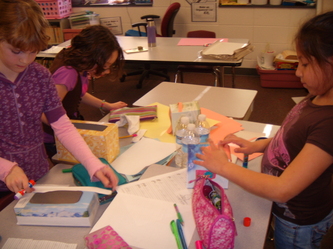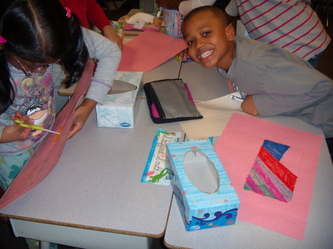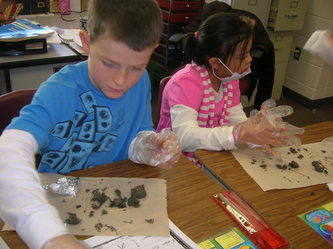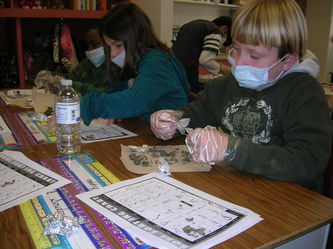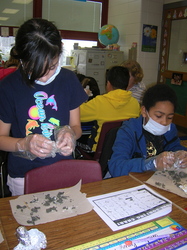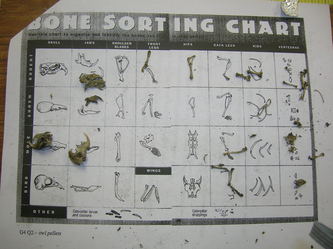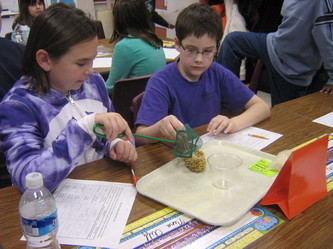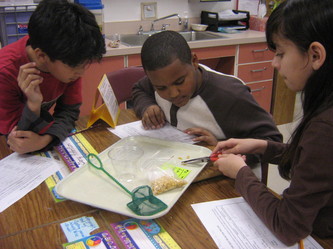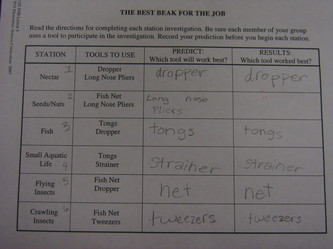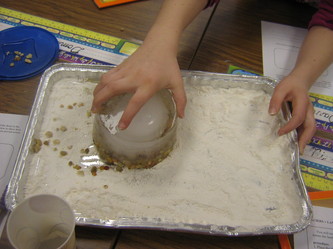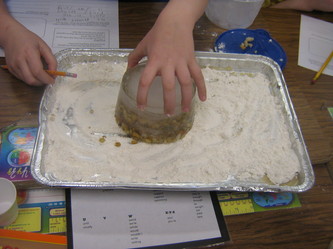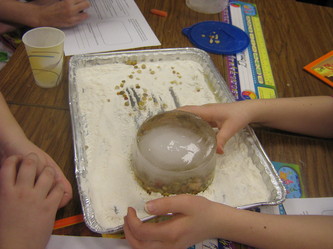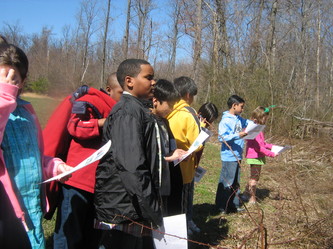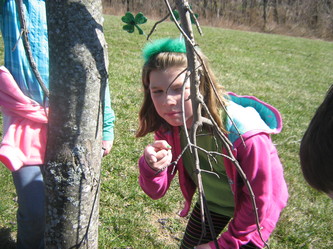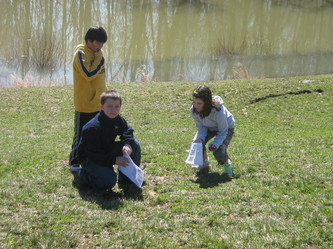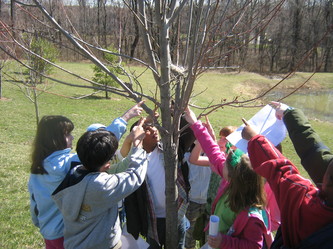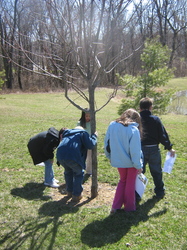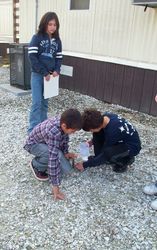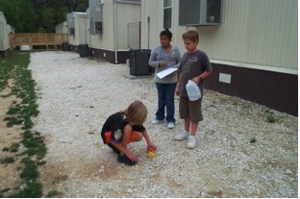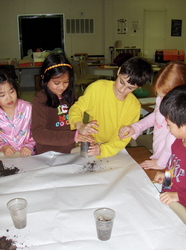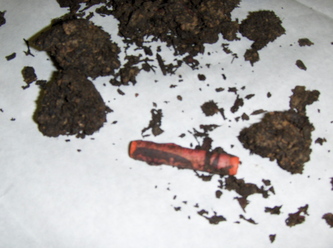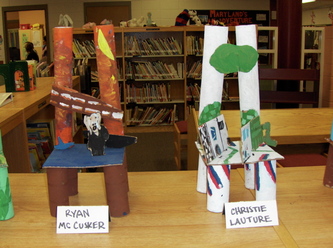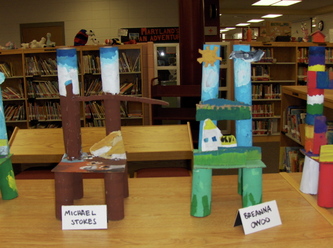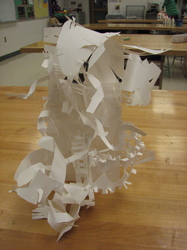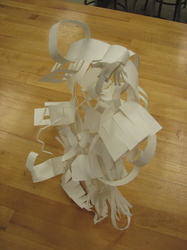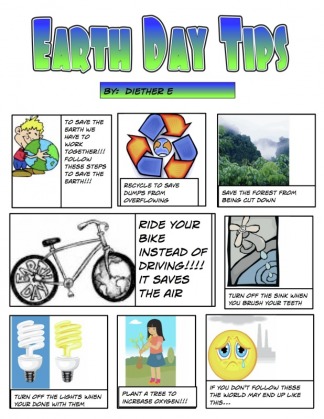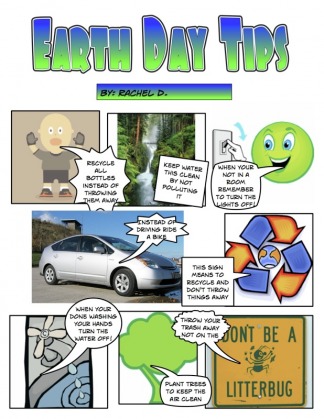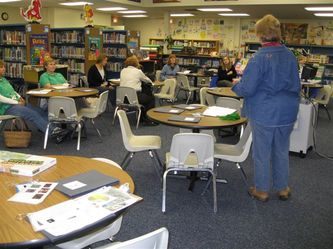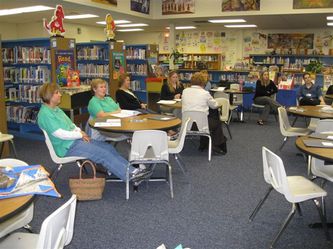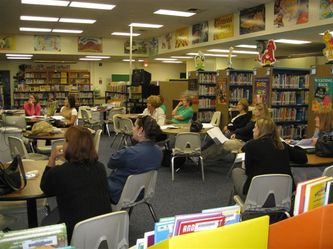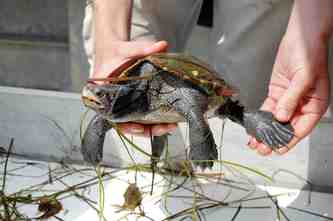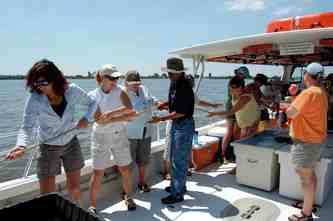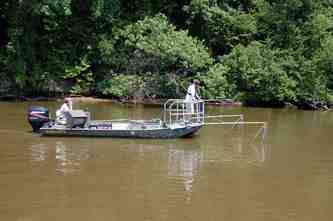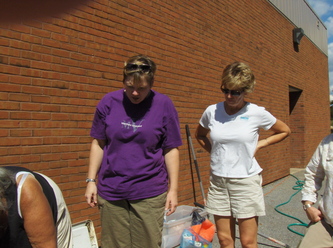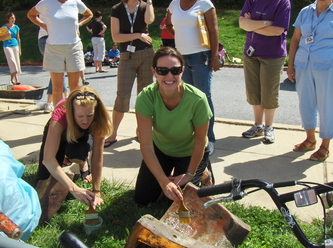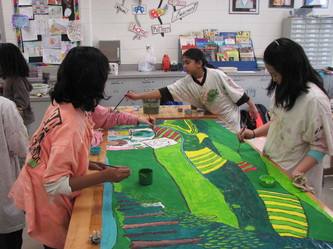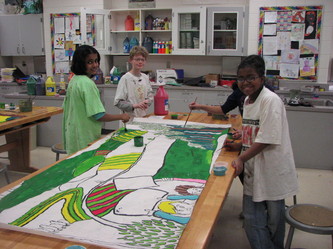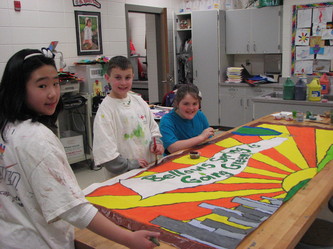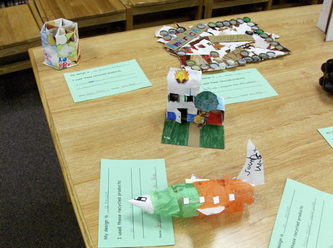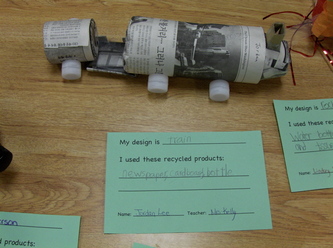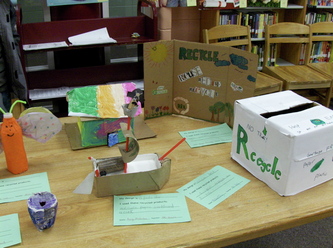Being Green at BSES
Environmental Issue Instruction
Preschool
Recycling with Oscar
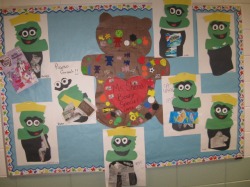
Even our youngest students are learning how to be responsible citizens. They are practicing and learning about recycling versus trash items. Oscar the Grouch helped them identify which items could be recycled.
Kindergaten
Reduce, Reuse, Recycle
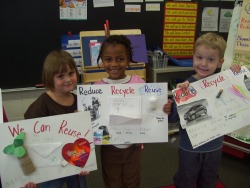
Kindergarten students learned about the three R's - reduce, reuse, and recycle. Not only were they activating their prior knowledge about what could be recycled, but they were also challenging their thinking to create other uses for everyday items instead of throwing them away.
| kreuse.pdf |
| krecycle2.pdf |
Decorating Grocery Bags

The kindergarten classes participated in The Earth Day Groceries Project. The kindergarten students at Bellows Spring Elementary School decorated Giant grocery bags to be distributed to customers on Earth Day, April 22, 2009.
They borrowed paper grocery bags from the Giant Food store in Lyndwood Center. The students then decorated the bags with environmental messages about reducing, reusing and recycling. Finally, the bags were returned to Giant and on Earth Day, April 22, customers received their groceries— along with the message that kids care about our environment— in the decorated bags.
The goal was to enhance students’ environmental knowledge, along with skills in art, computer science, geography, math and science. It helped to educate and empower our Bellows Spring students to make a difference in our community.
They borrowed paper grocery bags from the Giant Food store in Lyndwood Center. The students then decorated the bags with environmental messages about reducing, reusing and recycling. Finally, the bags were returned to Giant and on Earth Day, April 22, customers received their groceries— along with the message that kids care about our environment— in the decorated bags.
The goal was to enhance students’ environmental knowledge, along with skills in art, computer science, geography, math and science. It helped to educate and empower our Bellows Spring students to make a difference in our community.
What to do with those broken crayons?
The students in Mrs. Bone's class spent some down time in class peeling the paper off of old, stubby crayons. That paper was placed in the recycling bin. Once all the paper was removed, the class broke the crayons into even smaller pieces. She talked with the students about what it means to recycle (you can take something old and make it into something new). Mrs. Bone then explained to them that they would use the old crayons that they peeled and broke to make new crayons. Each child was given a foil cupcake liner and was allowed to pick different pieces of crayons to fill the liner. The liners were placed in a muffin pan and then placed in the oven to melt. Once melted, they took them out of the oven to cool. Once the crayons were cool, the students peeled the foil off and were able to draw with their new crayons.
First Grade
The Lorax
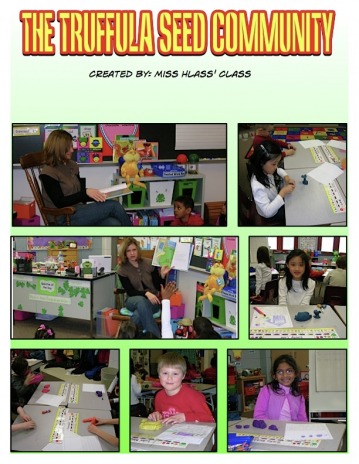
| truffula_seed_lesson_plan.doc |
| 1story.pdf |
| exit_ticket.doc |
Second Grade
Chesapeake Bay Project
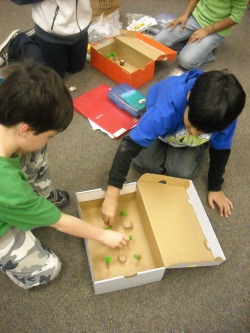
Several second graders learned about the source of various problems the Chesapeake Bay is currently facing. These problems stem from crabbing, dredging oysters, clearing forests, farming and boating. Students were able to discuss problems related to the bay, as well as cooperatively create solutions for these problems in a small group setting. Students also created diorama displays in order to showcase what they learned about the various problems and their proposed solutions.
Community Gardens
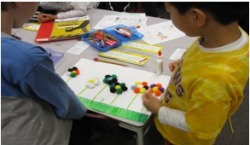
Students listened to Wicker School Takes Action and City Green to activate prior knowledge and to determine ways to improve our schoolyard and community. They then wrote a letter to their neighbors and friends asking for their support in creating a community garden. The students needed to give three reasons for why a garden would be good for the neighborhood. Students were also asked to create a garden mural.
| community_garden.pdf |
Third Grade
Vibrating Violins
3rd Grade Science Experiment
While studying sound, students created instruments out of everyday, reusable materials. They worked on testing the vibrations and comparing how sound waves travel. Using a paper cup, string, and a paperclip allowed them to see that they could create instruments out of materials they can find anywhere, rather than throwing them away. The students were then given a challenge to go home and create their own instruments from items they would otherwise throw in the trash.
While studying sound, students created instruments out of everyday, reusable materials. They worked on testing the vibrations and comparing how sound waves travel. Using a paper cup, string, and a paperclip allowed them to see that they could create instruments out of materials they can find anywhere, rather than throwing them away. The students were then given a challenge to go home and create their own instruments from items they would otherwise throw in the trash.
Global Community (spring 2011)
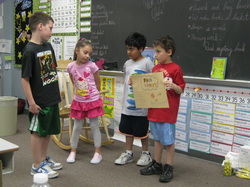
Third graders learned how to help the global community. The students had to identify a problem, create, and present a proposal about one way they could help the environment and our global community. Examples of a proposals include organizing a beach cleanup or creating a school wide garden that they school and community could use.
Cheetah Club
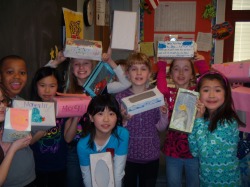
On Friday, March 5, 2010, Ms. Fogler conducted a green activity for Cheetah Club (a biweekly school reward). The purpose of her activity was to reduce, reuse and recycle old tissue boxes and transform them into new and exciting items for the students to use. Some of the new items included piggy banks, tissue box covers, treasure chests, a diaroma and a collectibles box for favorite items. The students enjoyed this activity because it gave them an outlet to be creative while helping the environment.
Fourth Grade
Dissecting owl pellets

One of the most exciting science activities that occurs in fourth grade is the dissection of an owl pellet. Before the dissection, students learn about food chains and food webs. They discover how owls are unable to digest everything that they eat, and regurgitate some of these items, which include bones and fur, into a "pellet." Students use a bone sorting chart to help them identify the creature that the owl last ate. They are amazed when they can find a whole small animal, which may include a bird, shrew, or mole. This activity allows students to gain a deeper understanding of the animals that live in our environment.
Bird Beaks
Students used science "tools of the trade" to decipher what type of beak would best help different varieties of birds when finding food. They were given six different scenario cards that described situations where a bird would need to find food. Students then had to test the tools, which included tweezers, nets, eye droppers, tongs and strainers. They learned that longer beaks could find food in small crevices, while larger, deep beaks could easily get food while in flight. This lesson teaches the importance of a creatures ability to make adaptations in the environment in which they live.
Understanding weathering
Students in fourth grade learned about both slow changes that affect the surface of the Earth, such as erosion and weathering, as well as fast changes, such as volcanic activity and earthquakes. They did several different simulation activities to make the experiences more meaningful and hands-on. When learning about erosion, students used a small clay ball and shook it in a canister for five minutes, first with water, and then with water, sand, and gravel. This enabled them to gain an understanding that water erosion affects the surface of the earth. To further reinforce the idea of weathering, students were given a small block of ice with small rocks underneath. They then slowly guided this "glacier" through flour to see the effects of what occurs when a glacier melts. Finally, in gaining more understanding of volcanic activity, students were given a tube of toothpaste to represent magma, and poured soil into a see-through cup to witness the rise of magma, and what happens to the soil on the top layer. These experiences proved to be fun and rewarding for the students in fourth grade, and allowed them to understand how the surface of the earth changes due to natural weathering events .
Nature Walk
On March 17, 2010, students in Ms. Beach's class took a nature walk outside the school grounds. Before they went outside, they discussed what types of habitats they might find. They were given resource sheets with pictures to help them identify signs of nature on the school grounds. On the walk, they found signs of life in trees, on the ground, and in the sky. A few of the highlights included finding deer tracks, discovering a birds nest, and seeing geese in our school drainage pond.
Fifth Grade
Permeability
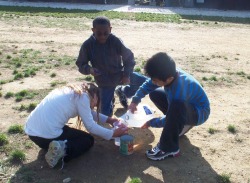
Slurpy Surfaces- September 11, 2008
Students in Ms. Thompson's homeroom visited the various sites on their site map to conduct a permeability test of each surface. In each case, they looked for either “soak in” or “run off”. They timed the “soak in” for speed of absorption and ranked the various surfaces in terms of how they benefit our stream.
Students sat outside and discussed which surfaces were the most beneficial for “catching” rainwater and preventing run-off, as well as which were the worst.
Students in Ms. Thompson's homeroom visited the various sites on their site map to conduct a permeability test of each surface. In each case, they looked for either “soak in” or “run off”. They timed the “soak in” for speed of absorption and ranked the various surfaces in terms of how they benefit our stream.
Students sat outside and discussed which surfaces were the most beneficial for “catching” rainwater and preventing run-off, as well as which were the worst.
Run Off Maps
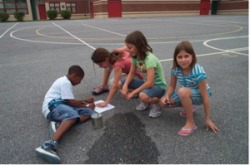
School Site Map-- September 8, 2008
Students in Ms. Thompson's homeroom went outside to create a site map of the Bellows Spring grounds, color-coding the different surfaces. Students also located the downspouts from the portables and the main school building. They coded in the location for the Deep Run stream that is the boundary for much of the schoolyard and runs through the school’s property. They coded the location of the drainage pond that was added after the school was built.
Students in Ms. Thompson's homeroom went outside to create a site map of the Bellows Spring grounds, color-coding the different surfaces. Students also located the downspouts from the portables and the main school building. They coded in the location for the Deep Run stream that is the boundary for much of the schoolyard and runs through the school’s property. They coded the location of the drainage pond that was added after the school was built.
Gifted and Talented Classes
Archaeology Group
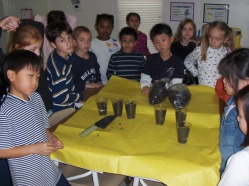
Second grade students learned about archaeology in the Can We Dig It Curriculum Extension Unit. They also discussed the differences between artifacts that are biodegradable and non-biodegradable. These are big words for second graders, but they were able to grasp the concept through this three-week long experiment. Students picked items to bury in soil and then water everyday for the duration of the experiment to simulate the artifact being buried outside in the ground. The students made predictions about what would happen to each artifact and whether any part of the artifact was biodegradable or non-biodegradable. They learned that metal items rust over time and deposit that into the soil, paper items, along with food, decompose, plastic items just get dirty, and material also gradually decomposes.
| digging_up_facts.pdf |
| big_dig.pdf |
Ocean Systems
In one part of the the Oceanography unit, “Making Waves”, students studied the global concepts of ocean systems. Each group of four students were assigned a part of the ocean to study, such as kelp gardens, hydrothermal vents, estuaries, and coral reefs. The children created dioramas showing the chemical, physical, geological, and biological properties of each system. Students learned how they work and WHY we must conserve water and protect our oceans. One fifth grader said, “Our lives depend on the health of the ocean!” She’s right! These stories highlight the problem of pollution in our oceans.
| allie.pdf |
| micah.pdf |
| samuel.pdf |
Zams Quest
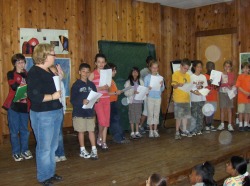
For the past two years, both third and fourth grade students participated in “Zam’s Quest”. The hope was to instill the desire to continue learning about problems with animals’ welfare and spark a desire to solve the problems in a creative manner.
Our fourth grade students were able to complete a second unit on oil spills and the effect on sea birds. As a final product, the children created ways to help the sea birds during (or before) an oil spill takes place.
The fourth graders presented their work at the Baltimore Zoo, sponsors of “Zam’s Quest”, on May 18, 2009. The audience consisted of other children who participated in this program, as well as employees and guests of the zoo. It was a great culminating activity to our unit.
Our fourth grade students were able to complete a second unit on oil spills and the effect on sea birds. As a final product, the children created ways to help the sea birds during (or before) an oil spill takes place.
The fourth graders presented their work at the Baltimore Zoo, sponsors of “Zam’s Quest”, on May 18, 2009. The audience consisted of other children who participated in this program, as well as employees and guests of the zoo. It was a great culminating activity to our unit.
Earth Alert Seminar
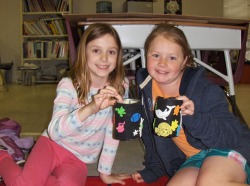
What does being “GREEN” mean?
The goal of this group was to discuss and learn about water conservation, recycling, pollution, habitats and how KIDS can help save the earth. Our hope is to educate the children on how to start NOW!
We started off looking at what we can do to recycle at home and learn about the recycling symbols. We then took a look at our habits at home when it came to using electricity, recycling plastic and glass, or saving water when possible.
We wrote letters to restaurants and grocery stores asking them to stop handing out balloons. We felt balloons were polluting the earth and hurting animals that swallowed them. We also “reused” tin cans. We wrapped them in felt and decorated them to use as pencil holders. We donated them to a senior housing facility. We collected food containers and reused them to store crayons, buttons, matchbox cars and more!
The goal of this group was to discuss and learn about water conservation, recycling, pollution, habitats and how KIDS can help save the earth. Our hope is to educate the children on how to start NOW!
We started off looking at what we can do to recycle at home and learn about the recycling symbols. We then took a look at our habits at home when it came to using electricity, recycling plastic and glass, or saving water when possible.
We wrote letters to restaurants and grocery stores asking them to stop handing out balloons. We felt balloons were polluting the earth and hurting animals that swallowed them. We also “reused” tin cans. We wrapped them in felt and decorated them to use as pencil holders. We donated them to a senior housing facility. We collected food containers and reused them to store crayons, buttons, matchbox cars and more!
| footprint.doc |
| green_inventory.doc |
Art Instruction
Artist Inspiration Chairs
Students were given four artists/artworks to choose from and were asked to create a three-dimensional chair inspired by the artwork. Materials used for this assignment included paper towel tubes, toilet paper tubes, cardboard, and tempura paint. Students began by sketching an idea of his/her chair, and pasting paper towel and toilet paper tubes to a cardboard square to make the basic framework of a chair. Students then began to cut and paste cardboard pieces onto the chair based on what was in the artwork they chose. They had to include a backrest on their chair and at least three objects from the artwork that would have to be cut and pasted onto the basic framework of the chair. After completion of the chair's construction, students painted the chair using similar colors and brush strokes that the artist used in his/her work. Students were able to see that ordinary things could be reused and transformed into a beautiful piece of art.
Calder Sculptures
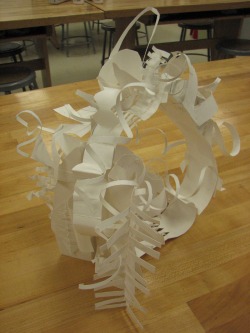
Fourth graders in Ms. Rubock's art class were taught about the sculptures of Frank Stella. They learned about the lines that Stella created when he formed his large all-white sculpture that appears to be floating in the air (this sculpture is located at the National Gallery). For this assignment, the students worked in teams of three or four and the goal was to create a 3-D sculpture out of one piece of flat poster board. They were encouraged to use ALL of the paper. At the end of every day, they saved their scraps instead of throwing them into the recycle bin so that they could continue sculpting with them the following week. They used many different paper folding/cutting techniques to make their sculptures unified and interesting! Each turned out different and ordinary paper was completely transformed in beautiful works of art!
Educational Technology Instruction
Earth Day Tip Comic Strips
During Earth Week, students in Educational Technology class brainstormed various ideas of how to help the planet. The students used the ideas to create comic strips using a program called Comic Life.
Professional Development
Howard County Going Green Workshop Series
Three teachers from our school attended several informative Maryland Green School Workshop series. The presentations were co-sponsored by the Howard County Conservancy and the Howard County Public School System. The focus was to provide guidance for educators who were interested in making their school a Maryland Green school. Speakers from the Maryland Association for Environmental and Outdoor Education, the Maryland Agricultural Education Foundation, the Alliance to Save Energy, and Master Gardeners attended these events. Educators learned about topics and ideas that could help them in their quest to become "Green," and they also were able to collaborate with one another for support and guidance along the way.
| green_school_workshop_agenda_january_1409.doc |
| green_school_workshop_agenda_october_22.doc |
| green_school_workshop_agenda_march_1109.doc |
Howard County Conservancy Nature Walk
Two teachers from our school, Mrs. Kim and Ms. Beach, attended a workshop to learn best ways to introduce students to nature walks. At the workshop, the teachers were provided resources that could be used for students, and they also learned about types of native plants and species that live in the state of Maryland. At the conclusion of the workshop, the teachers took a walk outside the school grounds to gather more experience for best teaching the children.
Green Fest
Green Fest is a county-wide celebration of environmental and conservation efforts. In April 2009, Ms. Beach, fourth grade teacher, attended the event to learn more about what is occurring around the county. While there, she helped to plant a tree, discovered ways to conserve in the home and school environments, and learned about native plants in Maryland.
| greenfest.pdf |
Ms. Thompson- 5th Grade Teacher
July, 2008
CC5-EF Earth Force (Advanced Course)- 2 credits
This was a course designed to immerse the teachers who are Chesapeake Classoom Alumni in the culture of Smith Island. This involved meeting and spending time with the residents of Smith Island, the watermen and their wives, as well as marine biologists from Virginia Institute of Marine Science. We spent a week on the island and on workboats. We evaluated the health of the Bay based on water testing, the testimonials of the Smith watermen, and the marine biologists from VIMS. Very interesting diverse perspectives on what's wrong and how to fix it. We also visited a pelican rookery near Tangier Sound.
July, 2009
CC5-TOB Teachers on the Bay (Advanced Course)- 3 credits
Tidal/Coastal Areas in Virginia
This course involved a week of exploring the Rapphannock and the Bay onboard a research vessel. We conducted a bald eagle survey as we sailed on the Rapphannock and met with the Fish and Wildlife team who were doing a fish count, examining the impact of an invasive species of catfish. Also spent 2 nights on a remote island near Tangier Sound called Great Fox Island, now mostly underwater and marshy. We performed biological and water quality testing, as well as profiling of dead zones. We conducted scrapes and pulled up an amazing cross-section of Bay inhabitants, including diamondback terrapins. We also kayaked to a nearby uninhabited island that serves as a breeding ground for Royal Tern, as well as other native birds.
CC5-EF Earth Force (Advanced Course)- 2 credits
This was a course designed to immerse the teachers who are Chesapeake Classoom Alumni in the culture of Smith Island. This involved meeting and spending time with the residents of Smith Island, the watermen and their wives, as well as marine biologists from Virginia Institute of Marine Science. We spent a week on the island and on workboats. We evaluated the health of the Bay based on water testing, the testimonials of the Smith watermen, and the marine biologists from VIMS. Very interesting diverse perspectives on what's wrong and how to fix it. We also visited a pelican rookery near Tangier Sound.
July, 2009
CC5-TOB Teachers on the Bay (Advanced Course)- 3 credits
Tidal/Coastal Areas in Virginia
This course involved a week of exploring the Rapphannock and the Bay onboard a research vessel. We conducted a bald eagle survey as we sailed on the Rapphannock and met with the Fish and Wildlife team who were doing a fish count, examining the impact of an invasive species of catfish. Also spent 2 nights on a remote island near Tangier Sound called Great Fox Island, now mostly underwater and marshy. We performed biological and water quality testing, as well as profiling of dead zones. We conducted scrapes and pulled up an amazing cross-section of Bay inhabitants, including diamondback terrapins. We also kayaked to a nearby uninhabited island that serves as a breeding ground for Royal Tern, as well as other native birds.
Learning how to make Oyster Reef Balls
Concrete anyone? In the fall of 2008, our principal, Jackie Klamerus, administrative intern, Nancy Richardson, Gifted and Talented teacher, Amy Colman, and a parent, Amy LaMoure, gathered at one of our staff development centers to learn about the Oyster Reef Balls. An environmental activist, Sandy August, came out to educate county teachers about this program and to involve them in a hands-on experience while making them. They later used this knowledge to help fourth and fifth graders create three orbs for our school to send off to the Chesapeake Bay.
Mrs. Colman - Gifted and Talented Resource Teacher
Mrs. Colman recently attended a seminar on Solar Energy put on by a company called "Solar Energy World" in Jessup, Maryland. We talked about the sun being an untapped source. They explained how the solar panels work, what direction is optimum for the best sun exposure, how it is cost effective, how clean this form of energy is, and how we can become "energy independent". Solar energy is "smart" because by using the sun, we can guarantee clean energy for our future generations. We can become part of the solution. This information will be used in Mrs. Colman's Earth Alert Seminar.
Celebration
Green Day: Kick Off
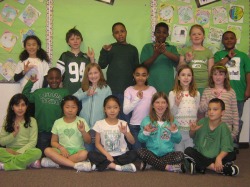
On Tuesday, January 13, 2008, the fifth grade students from Mrs. English's seminar group presented information to all lunch shifts regarding the cafeteria going green. To officially kick this off, we asked all staff and students to wear green on that day. Announcements were made in the morning and afternoon to remind students and staff to show their support of recycling in the cafeteria.
Community Picnic

As a culminating activity and a celebration to a job well done after our Celebrate Green Day, the community gathered back at the school for a picnic. All the families brought a picnic lunch and we relaxed in front of our newly landscaped school yard.
T-shirt Contest
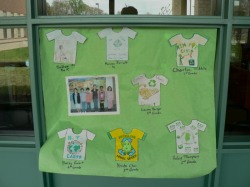
To create excitement for our "Celebrate Green" community event, we held a t-shirt design contest throughout the school. Students were asked to create a design that promoted our event. There was great enthusiasm for this contest and students from preschool through fifth grade participated. The Green Committee voted on the winners of the designs. It was difficult to choose from over the 100 choices, but a winner from each grade was chosen along with an overall winner. The big winner was a fifth grade student and she was thrilled to see her design become an actual t-shirt that was worn by all the volunteers on the event day.
| tshirt_contest.pdf |
Art Mural
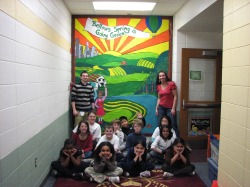
As an after school workshop, students in fifth grade were chosen to help show their dedication to becoming green by creating a mural. This mural was temporarily placed in a hallway to disguise our boards for an addition being built, but it will be permanently placed in the cafeteria for all to see.
America Recycles Day

Our school celebrated America Recycles Day by challenging the students to create a sculpture or design at home from only recyclable goods. This contest helped to enforce the concept of reusing items while also celebrating our efforts to recycle in our community homes. When students or families finished their design, they brought them into the school to be displayed in the media center and during parent teacher conferences. All participants were recognized with a certificate and our green committee selected three overall design winners from the school. These winners were further recognized over the announcements and in a photograph that will make a lasting impression in our yearbook. What a fun way to see the creative side of our students!
| amrecycles1.doc |
| certificate.pdf |
Second Grade Walking Field Trip
Second graders and staff members participated in a "walking field trip" through our schools' neighboring communities to celebrate Earth Day. The students planted beautiful flowers into cups, which were donated by local nurseries, and shared these plants with the community on Earth Day. In addition to sharing the flowers, students wrote poems and stories about conserving our Earth, which they also left on our community members' doorsteps. The students learned so much about the importance of conserving our Earth while simultaneously spreading beauty and awareness to the community.
| 2ndgradegreenpowerpoint.ppt |
Helping the community to live Green one step at a time

At the parent-teacher conferences last year, every Bellows Spring family was presented with a reusable bag funded by our fabulous PTA. Families had the option to purchase more bags if they were interested. This year the trend continues; as new kids and kindergarten students enroll they are also given the reusable bag. This was a great way to support our families and to be visible in the community as a school that cares about the environment.
| bs20goes20green-bags1.doc |
